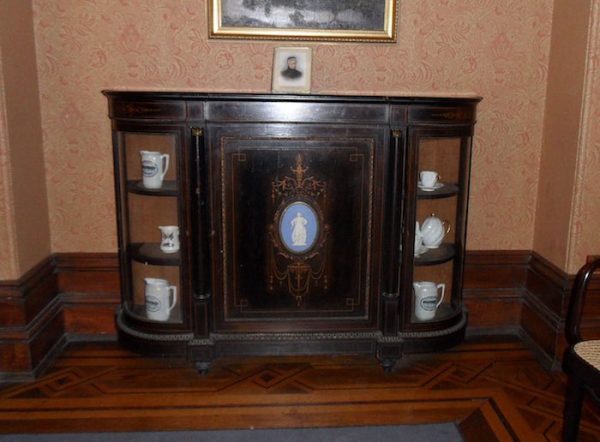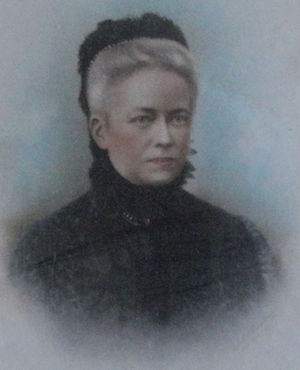Written by Dr Catherine Bishop, Macquarie University
To celebrate Women’s History Month in 2020, the Royal Australian Historical Society will continue our work from last year to highlight Australian women that have contributed to our history in various and meaningful ways. You can browse the women featured on our webpage, Women’s History Month.
Among the pieces of furniture exuding appropriate historic ambience in RAHS’s History House in Macquarie Street is a magnificent sideboard. The silver plaque attached to the top acknowledges this as a woman’s piece of furniture, handed down to daughters, not sons, and then given to the RAHS in 1953 by Beatrice How, rather than to her only child, Robert. The plaque reads:
Mrs Margaret Doak, 1838
Passed to
Mary Jane Beattie, 1860–
Jessie Douglas McRae, 1907–
Beatrice Dorothy How, 1934–

Margaret Doak’s sideboard [History House, Macquaire Street, Sydney]
Mary Jane (Minnie) Beattie – nee Doak
3rd March 1839 – 6th August 1907
Married to James Beattie, 5th October 1858.

Photograph of Mary Jane ‘Minnie’ Beattie [History House, Macquarie Street, Sydney][History House, Macquarie Street, Sydney]
Minnie Beattie was a second-generation dressmaker. When her husband died she joined the established business run by her mother, Margaret Doak, and her aunt, Rebecca Kerr. It is likely that she was already familiar with it, as her mother had been in business since before Minnie was born. Margaret Doak immigrated to Sydney in 1840 from Londonderry in Ireland with her husband, Anthony, and four children, including Minnie, as well as her father and several sisters. Margaret was already a businesswoman with a millinery and dressmaking business next door to her husband’s carpentry business in Londonderry’s Society Street.
Upon reaching Sydney, Anthony and Margaret Doak immediately went into partnership with one of Margaret’s sisters, Rebecca Kerr. ‘Doak and Kerr’ became an established firm in Sydney, patronised by city women as well as those from further afield. The diary of squatter’s wife Mary Braidwood Mowle, on the Limestone Plains (now Canberra), then a remote bush outpost, noted that she had corresponded with Doak and Kerr in Sydney. The business survived financial difficulties in 1855 and the death of Anthony in 1857.
The company known as Doak and Kerr announced that it was closing in June 1859, but Mrs Doak continued to advertise as a milliner and dressmaker. The business was then known as ‘Mrs Doak’s’ until December 1873, when a small one-line advertisement advised, ‘Mesdames Doak and Beattie will resume Business on the 3rd January’. By this time the business was in Belmore House in fashionable Wynyard Square. The rest of the Square was home to the Post Office and Council Chambers, dentist, doctors and commission agents, as well as several boarding houses and two hotels, one of which, the Town Hall Family Hotel, was run by the Misses Eliza Jane and Isabella Horner. Widow Mrs Mary Saclier ran a ladies’ academy on the other side of the square, making the most of her French surname, although she was actually Irish. This was an unimpeachable location for a millinery business. The business was known as ‘Doak and Beattie’ until Margaret Doak’s death at the age of 80 in 1883. Although 11 years younger, her sister Rebecca, who seems to have lived with her, died a few months later.
Margaret Doak left her daughter an estate of about £2400 – including the sideboard as well as bank deposits, shares and a thriving business. Faced with increasing competition from department stores, Minnie went upmarket, trading as ‘Madame Beattie’ and becoming a very fashionable dressmaker. Her customers included Bessie Rouse of Rouse Hill Estate. In 1886 Bessie paid twelve guineas for a black lace satin ‘dressover’, a garment that survives in the Rouse Hill House & Farm museum. By this time Madame Beattie was specialising in ‘Wedding Trousseau, Ball, Demi and Visiting Toilets’ – and in 1889 her business was described as ‘an elite costume studio’. She opened a new department for tailor-made riding habits, mantles and Directoire jackets, which were elegant, tightly fitting garments. She also added to her staff and advertised the appointment of Monsieur Ryback, a ‘ladies’ tailor from the West End of London’. According to the ‘Society Gossip and Fashionable Fancies’ section of the Illustrated Sydney News, Madame Beattie had a reputation for style and ‘that hard-to-define effectiveness which the French term chic denotes’. Minnie remained in business until her death in 1907.
Margaret Doak, Rebecca Kerr and Minnie Beattie ran a 70-year-long business, moving across the world from Londonderry to Sydney and adapting to meet the demands of the colonial market with increasing competition from big business. Yet their story has been almost forgotten. Even their descendant Beatrice How did not think it an important story to tell when she donated the sideboard to the RAHS in 1953. One wonders, if it had been David Jones’ sideboard, would he have been described merely as ‘David Jones, husband of Jane Jones’? Probably not. Minnie, Rebecca and Margaret were just three of thousands of Australian businesswomen in the nineteenth century – their business was among the more long lasting – but all deserve recognition for the parts they played in the development of the Australian economy and society more generally.
For more information about these and other businesswomen across the world see: Catherine Bishop, Minding Her Own Business: Colonial Businesswomen in Sydney (New South Books, 2015) and Women Mean Business: Colonial Businesswomen in New Zealand (Otago University Press, 2019); Jennifer Aston and Catherine Bishop (eds), Female Entrepreneurs in the Long Nineteenth Century: A Global Perspective (Palgrave Macmillan, 2020).

0 Comments